Related Research Articles

Eugène Emmanuel Viollet-le-Duc was a French architect and author who restored many prominent medieval landmarks in France, including those which had been damaged or abandoned during the French Revolution. His major restoration projects included Notre-Dame de Paris, the Basilica of Saint Denis, Mont Saint-Michel, Sainte-Chapelle, and the medieval walls of the city of Carcassonne, and he planned much of the physical construction of the Statue of Liberty. His later writings on the relationship between form and function in architecture had a notable influence on a new generation of architects, including Victor Horta, Hector Guimard, Antoni Gaudí, Hendrik Petrus Berlage, Louis Sullivan and Frank Lloyd Wright.

Metropolis is a 1927 German expressionist science-fiction drama film directed by Fritz Lang and written by Thea von Harbou in collaboration with Lang from von Harbou's 1925 novel of the same name. Intentionally written as a treatment, it stars Gustav Fröhlich, Alfred Abel, Rudolf Klein-Rogge, and Brigitte Helm. Erich Pommer produced it in the Babelsberg Studios for Universum Film A.G. (UFA). The silent film is regarded as a pioneering science-fiction movie, being among the first feature-length movies of that genre. Filming took place over 17 months in 1925–26 at a cost of more than five million Reichsmarks, or the equivalent of about €21 million.
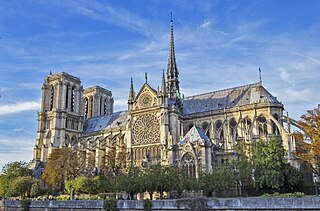
Notre-Dame de Paris, referred to simply as Notre-Dame, is a medieval Catholic cathedral on the Île de la Cité, in the 4th arrondissement of Paris. The cathedral, dedicated to the Virgin Mary, is considered one of the finest examples of French Gothic architecture. Several of its attributes set it apart from the earlier Romanesque style, particularly its pioneering use of the rib vault and flying buttress, its enormous and colourful rose windows, and the naturalism and abundance of its sculptural decoration. Notre Dame also stands out for its musical components, notably its three pipe organs and its immense church bells.

The Victoria and Albert Museum in London is the world's largest museum of applied arts, decorative arts and design, housing a permanent collection of over 2.27 million objects. It was founded in 1852 and named after Queen Victoria and Prince Albert.

The Cathedral of Vasily the Blessed, commonly known as Saint Basil's Cathedral, is an Orthodox church in Red Square of Moscow, and is one of the most popular cultural symbols of Russia. The building, now a museum, is officially known as the Cathedral of the Intercession of the Most Holy Theotokos on the Moat, or Pokrovsky Cathedral. It was built from 1555 to 1561 on orders from Ivan the Terrible and commemorates the capture of Kazan and Astrakhan. It was the city's tallest building until the completion of the Ivan the Great Bell Tower in 1600.

The Detroit Institute of Arts (DIA), located in Midtown Detroit, Michigan, has one of the largest and most significant art collections in the United States. With over 100 galleries, it covers 658,000 square feet (61,100 m2) with a major renovation and expansion project completed in 2007 that added 58,000 square feet (5,400 m2). The DIA collection is regarded as among the top six museums in the United States with an encyclopedic collection which spans the globe from ancient Egyptian and European works to contemporary art. Its art collection is valued in billions of dollars, up to $8.1 billion USD according to a 2014 appraisal. The DIA campus is located in Detroit's Cultural Center Historic District, about 2 miles (3.2 km) north of the downtown area, across from the Detroit Public Library near Wayne State University.

Art forgery is the creating and selling of works of art which are falsely credited to other, usually more famous artists. Art forgery can be extremely lucrative, but modern dating and analysis techniques have made the identification of forged artwork much simpler.

The National Library of Wales, Aberystwyth, is the national legal deposit library of Wales and is one of the Welsh Government sponsored bodies. It is the biggest library in Wales, holding over 6.5 million books and periodicals, and the largest collections of archives, portraits, maps and photographic images in Wales. The Library is also home to the national collection of Welsh manuscripts, the National Screen and Sound Archive of Wales, and the most comprehensive collection of paintings and topographical prints in Wales. As the primary research library and archive in Wales and one of the largest research libraries in the United Kingdom, the National Library is a member of Research Libraries UK (RLUK) and the Consortium of European Research Libraries (CERL).

Tyntesfield is a Victorian Gothic Revival house and estate near Wraxall, North Somerset, England. The house is a Grade I listed building named after the Tynte baronets, who had owned estates in the area since about 1500. The location was formerly that of a 16th-century hunting lodge, which was used as a farmhouse until the early 19th century. In the 1830s a Georgian mansion was built on the site, which was bought by English businessman William Gibbs, whose huge fortune came from guano used as fertilizer. In the 1860s Gibbs had the house significantly expanded and remodelled; a chapel was added in the 1870s. The Gibbs family owned the house until the death of Richard Gibbs in 2001.
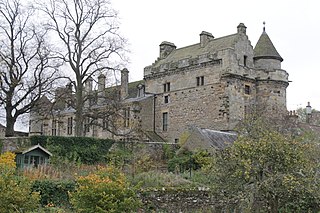
Falkland Palace, in Falkland, Fife, Scotland, is a royal palace of the Scottish Kings. It was one of the favourite places of Mary, Queen of Scots, providing an escape from political and religious turmoil. Today it is under the stewardship of Ninian Stuart, who delegates most of his duties to The National Trust for Scotland. The Chapel Royal in the Palace is dedicated to Thomas the Apostle, and is also open to the public and reserved for Catholic worship.
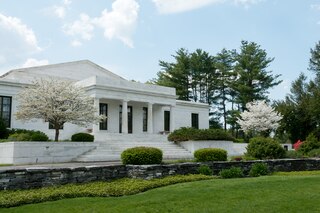
The Sterling and Francine Clark Art Institute, commonly referred to as the Clark, is an art museum and research institution located in Williamstown, Massachusetts, United States. Its collection consists of European and American paintings, sculpture, prints, drawings, photographs, and decorative arts from the fourteenth to the early twentieth century. The Clark, along with the Massachusetts Museum of Contemporary Art and the Williams College Museum of Art (WCMA), forms a trio of art museums in the Berkshires. The institute also serves as a center for research and higher learning. It is home to various research and academic programs, which include the Fellowship Program and the Williams College Graduate Program in the History of Art. It is visited by 200,000 people a year.
Heyday is an independent nonprofit publisher based in Berkeley, California.

An Ex Libris, also known as a bookplate, is a printed or decorative label pasted into a book, often on the front endpaper, to indicate ownership. Simple typographical bookplates are termed "book labels".

The conservation-restoration of the frescoes of the Sistine Chapel was one of the most significant conservation-restorations of the 20th century.

Sister Plautilla Nelli (1524–1588) was a self-taught nun-artist and the first known female Renaissance painter of Florence. She was a nun of the Dominican convent of St. Catherine of Siena located in Piazza San Marco, Florence, and was heavily influenced by the teachings of Savonarola and by the artwork of Fra Bartolomeo.

The nude, as a form of visual art that focuses on the unclothed human figure, is an enduring tradition in Western art. It was a preoccupation of Ancient Greek art, and after a semi-dormant period in the Middle Ages returned to a central position with the Renaissance. Unclothed figures often also play a part in other types of art, such as history painting, including allegorical and religious art, portraiture, or the decorative arts. From prehistory to the earliest civilizations, nude female figures are generally understood to be symbols of fertility or well-being.
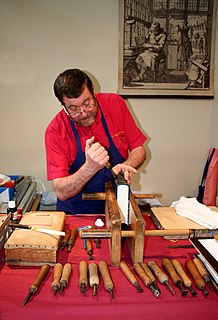
Bookbinding is the process of physically assembling a book of codex format from an ordered stack of paper sheets that are folded together into sections called signatures or sometimes left as a stack of individual sheets. Several signatures are then bound together along one edge with a thick needle and sturdy thread. Alternative methods of binding that are cheaper but less permanent include loose-leaf rings, individual screw posts or binding posts, twin loop spine coils, plastic spiral coils, and plastic spine combs. For protection, the bound stack is either wrapped in a flexible cover or attached to stiff boards. Finally, an attractive cover is adhered to the boards, including identifying information and decoration. Book artists or specialists in book decoration can also greatly enhance a book's content by creating book-like objects with artistic merit of exceptional quality.

Philipp Pinchas Fehl was an Austrian born American artist and art historian.
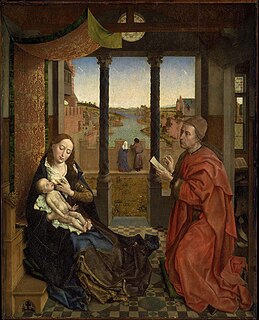
Saint Luke Drawing the Virgin is a large oil and tempera on oak panel painting, usually dated between 1435 and 1440, attributed to the Early Netherlandish painter Rogier van der Weyden. Housed in the Museum of Fine Arts, Boston, it shows Luke the Evangelist, patron saint of artists, sketching the Virgin Mary as she nurses the Child Jesus. The figures are positioned in a bourgeois interior which leads out towards a courtyard, river, town and landscape. The enclosed garden, illusionistic carvings of Adam and Eve on the arms of Mary's throne, and attributes of St Luke are amongst the painting's many iconographic symbols.
References
- ↑ "CMA Exhibition Feature : More About the Schweidler Restorers".
- ↑ Lauren Laz, Olivier Masson, and Michaela Ritter, 'Durer's Adam and Eve and a Possible 'Schweidlerization,' Print Quarterly, XXXI, 2014, pp. 259-269.
- ↑ Lauren Laz, Olivier Masson, and Michaela Ritter, 'Durer's Adam and Eve and a Possible 'Schweidlerization,' Print Quarterly, XXXI, 2014, pp. 259-269.
- ↑ M. Schweidler, The Restoration of Engravings, Drawings, Books and Other Works on Paper, translated from German and edited by R. Perkinson, Los Angeles, 2006 (Die Instandsetzung von Kupferstichen, Zeichnungen, Büchern usw., 1st edition, Stuttgart, 1938, 2nd edition 1950).